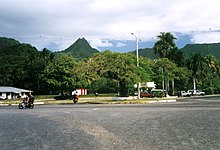|
Transport in the Cook IslandsThis article lists transport in the Cook Islands. Road transport The Cook Islands uses left-handed traffic.[1] The maximum speed limit is 50 km/h.[1] On the main island of Rarotonga, there are no traffic lights and only two roundabouts.[1] A bus operates clockwise and anti-clockwise services around the islands coastal ring-road.[2] Road safety is poor. In 2011, the Cook Islands had the second-highest per-capita road deaths in the world.[3] In 2018, crashes neared a record high, with speeding, alcohol and careless behaviour being the main causes.[4] Motor-scooters are a common form of transport, but there was no requirement for helmets, making them a common cause of death and injuries.[5][6] Legislation requiring helmets was passed in 2007, but scrapped in early 2008 before it came into force.[7] In 2016, a law was passed requiring visitors and riders aged 16 to 25 to wear helmets, but it was widely flouted.[8] In March 2020 the Cook Islands parliament again legislated for compulsory helmets to be worn from June 26, but implementation was delayed until July 31,[9] and then until September 30.[10]
Rail transportThe Cook Islands has no effective rail transport. Rarotonga had a 170m tourist railway, the Rarotonga Steam Railway, but it is no longer in working condition.[12] Water transport The Cook Islands have a long history of sea transport. The islands were colonised from Tahiti, and in turn colonised New Zealand in ocean-going waka. In the late nineteenth century, following European contact, the islands had a significant fleet of schooners, which they used to travel between islands and to trade with Tahiti and New Zealand.[13] In 1899, locally owned shipping carried 10% of all international trade to the islands, and 66% of all trade carried by sail.[13] Indigenous-owned shipping was driven out of business following New Zealand's acquisition of the islands, replaced by government-owned vessels, New Zealand trading companies, and the steamships of the Union Steamship Company.[13] International shipping is provided by Pacific Forum Line and Matson, Inc. (as EXCIL shipping). Only the port of Avatiu can handle containers, with ships unloading at Aitutaki using lighters.[14] There are two inter-island shipping companies: Taio Shipping, operating two vessels, and Cook Islands Towage, operating one. In the past, shipping interruptions have led to shortages of imported goods and fuel, and electricity blackouts on the outer islands.[15] Shipping has frequently been subsidised to ensure service.[16] In 2019 the Cook Islands government announced that it would acquire a dedicated cargo ship for the outer islands after Cook Islands Towage's barge was sold.[17] It subsequently delayed the purchase pending the development of a Cook Islands Shipping Roadmap, and issued a tender for a Pa Enua Shipping Charter.[18] The Cook Islands operates an open ship registry[19] and has been placed on the Paris Memorandum of Understanding on Port State Control Black List as a flag of convenience.[20] Ships registered in the Cook Islands have been used to smuggle oil from Iran in defiance of international sanctions.[21] In February 2021 two ships were removed from the shipping register for concealing their movements by turning their Automatic identification system off.[22] In April 2022 the motoryacht Tango owned by sanctioned Russian oligarch Viktor Vekselberg was seized in Spain.[23] Maritime Cook Islands claimed that no other sanctioned vessels were on its registry.[24] In July 2022 two yachts owned by sanctioned oligarch Roman Abramovich were reflagged as Cook Islands vessels, allowing them to escape arrest in Antigua and Barbuda.[25] In 2024 Maritime Cook Islands deflagged 12 tankers for violating sanctions against Russia and Iran. It denied that it had become a haven for Russia's "dark fleet" of sanctions-evaders.[26] Ports and harboursThe smaller islands have passages through their reefs, but these are unsuitable for large vessels. Merchant marine
Air transport The Cook Islands is served by one domestic airline, Air Rarotonga. A further three foreign airlines provide international service. AirportsThere is one international airport, Rarotonga International Airport. Eight airports provide local or charter services. Only Rarotonga and Aitutaki Airport are paved.
References
External linksWikimedia Commons has media related to Transport in the Cook Islands. |